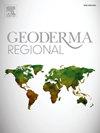Impacts of reclaimed water irrigation on mulch decomposition, microbial activity, and soil nutrient availability in the Brazilian semi-arid
IF 3.3
2区 农林科学
Q2 SOIL SCIENCE
引用次数: 0
Abstract
Knowledge gaps persist regarding mulch decomposition, nutrient dynamics, and microbial responses in semi-arid soils under reclaimed water irrigation. This is a critical issue for water-scarce regions like the Brazilian semi-arid. This study evaluated these processes in cactus-sorghum intercropping systems with mulch under irrigation depths with reclaimed water. The study employed a randomized block design with four replicates, testing irrigation depths of 0 %, 80 %, 100 %, and 120 % of sorghum ETc. Mulch decomposition was monitored for 165 days using litter bags, with subsequent C/N analysis of residual biomass. Soils at 0–0.10 m and 0.10–0.20 m depths were sampled to determine the contents of NO₃−, NH₄+, P, and microbial biomass C (MB-C), basal soil respiration, and aromatization index (ALIFS). Decomposition revealed the highest rates at 10 days (16 %) under 80 % ETc and at 25 days (24 %, 22 %, and 21 %) under 80 %, 100 %, and 120 % ETc, surpassing non-irrigated soils. Residue half-life was 182–196 days. Mulch N content declined most sharply at 10 days (1.2–1.8 g kg−1 in irrigated treatments). Soil NH₄+ and NO₃− peaked in the 0–0.10 m layer, but nitrate decreased by 15–62 % at 65 days, signaling microbial disruption from water excess. MB-C dropped >90 % at 65 days but recovered by 165 days, with the 80 % and 100 % treatments showing the highest MB-C in surface soils. These treatments also increased available P₂O₅ by 46–216 mg kg−1 versus 0 % and 120 % ETc. The ALIFS was higher in irrigated soils, especially at 120 % ETc (0–0.10 m). Reclaimed water irrigation enhanced nutrient supply, decomposition, and microbial activity, reducing synthetic fertilizer dependency while improving soil health in semi-arid agroecosystems.

再生水灌溉对巴西半干旱地区地膜分解、微生物活性和土壤养分有效性的影响
关于再生水灌溉下半干旱土壤地膜分解、养分动态和微生物反应的知识差距仍然存在。对于巴西半干旱等缺水地区来说,这是一个关键问题。本研究在再生水灌溉深度下,评价了覆盖的仙人掌-高粱间作系统的这些过程。本试验采用随机区组设计,共设4个重复,分别试验灌水深度为高粱的0%、80%、100%和120%等。使用凋落物袋监测地膜分解165 d,随后对剩余生物量进行C/N分析。在0-0.10 m和0.10-0.20 m深度取样土壤,测定NO₃−、NH₄+、P、微生物生物量C (MB-C)、基础土壤呼吸和芳构化指数(ALIFS)的含量。在80%、100%和120%等条件下,10 d分解率最高(16%),25 d分解率最高(24%、22%和21%),均超过未灌溉土壤。残留半衰期为182 ~ 196天。地膜氮含量在第10天下降幅度最大(灌溉处理为1.2 ~ 1.8 g kg - 1)。土壤NH₄+和NO₃−在0-0.10 m层达到峰值,但硝酸盐在65天后下降了15 - 62%,表明水分过剩导致微生物破坏。65 d时MB-C下降90%,165 d时恢复,80%和100%处理的表层土壤MB-C最高。这些处理还使可用的P₂O₅增加了46-216 mg kg - 1,而不是0%和120%等。灌溉土壤的ALIFS较高,特别是在120% ETc (0-0.10 m)时。再生水灌溉增强了养分供应、分解和微生物活性,减少了对合成肥料的依赖,同时改善了半干旱农业生态系统的土壤健康。
本文章由计算机程序翻译,如有差异,请以英文原文为准。
求助全文
约1分钟内获得全文
求助全文
来源期刊

Geoderma Regional
Agricultural and Biological Sciences-Soil Science
CiteScore
6.10
自引率
7.30%
发文量
122
审稿时长
76 days
期刊介绍:
Global issues require studies and solutions on national and regional levels. Geoderma Regional focuses on studies that increase understanding and advance our scientific knowledge of soils in all regions of the world. The journal embraces every aspect of soil science and welcomes reviews of regional progress.
 求助内容:
求助内容: 应助结果提醒方式:
应助结果提醒方式:


